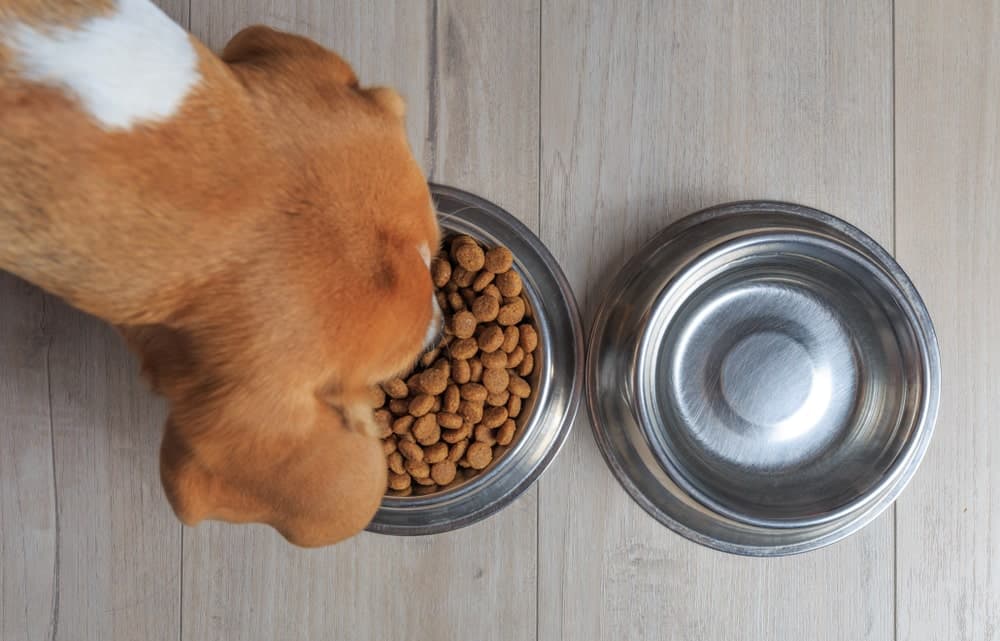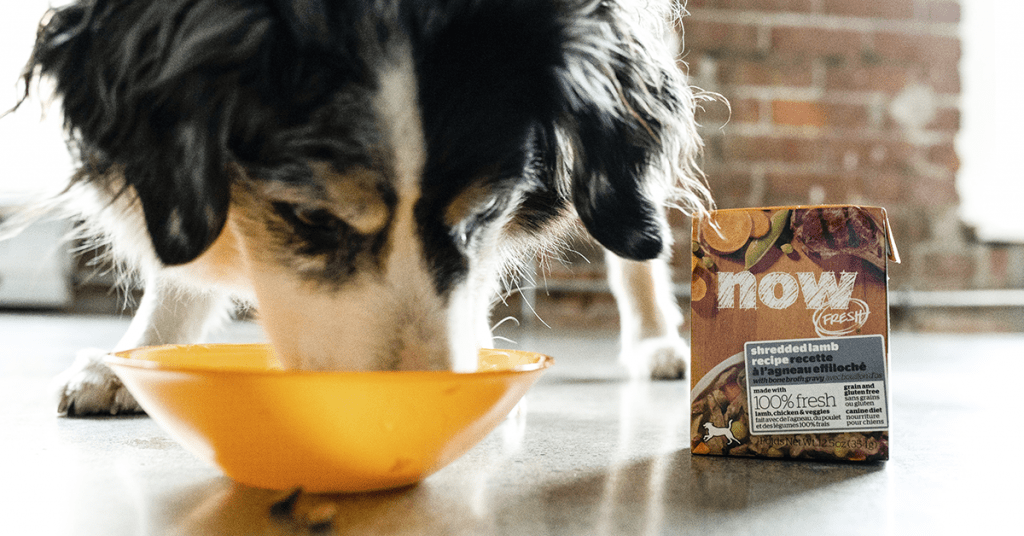“This post contains affiliate links, and I will be compensated if you make a purchase after clicking on my links.”
Dry food, wet food, or a combination of both? We’ve highlighted the benefits of each feeding method along with five easy tips to get you started with combination feeding.

By Natalie Asaro, MSc, Petcurean Nutrition Team
When it comes to our pets, we all want what’s best. We want to ensure they get enough love and attention, exercise, and food in their bowl. We also want to ensure that the food we feed them provides complete and balanced nutrition to help them thrive, with shiny coats and wagging tails. How we feed our pets has evolved over the years and we have more information than ever on what dogs need for balanced nutrition, food sensitivities, and approaches that can not only help with picky eaters but also appeal to a pup’s senses, making mealtime more enjoyable.
One of these approaches is called Combination Feeding, which is mixing wet with dry food. Combination is a great feeding option because both dry food and wet food have their own set of unique benefits. By mixing the two, your pup can receive the advantages of both.
With many pet parents out there today interested in learning more about optimal nutrition for their furry best friends, the nutrition team at Petcurean breaks it down with some key information and best practices when it comes to combination feeding for your precious pooch.
The Perks of Dry Feeding

Feeding your dog kibble has some distinct benefits and historically has been the most popular feeding option. Economically speaking, feeding your pup dry food is often the most cost-effective option. This becomes especially relevant if your household is home to multiple dogs. But, with this in mind, it’s important to do your research when it comes to picking a dry food option to ensure it is formulated as a complete and balanced meal. Dry food also has notable health benefits, including supporting your dog’s oral health as it can help to reduce plaque and tartar buildup. Some recipes even include specific ingredients to help counter bad breath! Additionally, the act of chewing kibble may offer stress-relief. Feeding your pup dry food is also a very convenient option, especially for those with a busy, on-the-go lifestyle, as it offers little to no prep time and doesn’t require refrigeration, making it an ideal option for frequent travelers and those with busy schedules.
Wet Food Has Its Benefits, Too
Wet food is highly palatable and tends to be an exciting option for dogs. This makes wet food a great choice for picky eaters, and for pets that require a soft diet because of dental issues or missing teeth. It also offers great variety when it comes to textures and flavors of the food. For example, Petcurean’s new NOW FRESHTM wet food recipes offer wet food for dogs in a variety of flavors available in a unique shredded texture, as well as the more traditional stews and pâtés, providing your pup with more texture options than ever before. They even offer two recipes specific to small breed dogs.
Wet food also offers more moisture and increases your pups’ water intake. Moisture content is a main differentiator between wet and dry pet foods. Dry diets contain only about eight to 12 percent water while wet formulations can have upwards of 80 percent moisture content. If your pet needs to take in a little extra water, adding in some wet food is a simple way to do this, providing extra hydration throughout the day.
Wet food recipes generally include high amounts of meat, resulting in higher levels of protein and fat, and lower levels of carbohydrate, compared to kibble. So, wet food makes a great option for pets who may require a higher protein, lower carbohydrate diet.
Wet food also comes in a variety of packaging options to suit your lifestyle. For example, NOW FRESH wet food recipes are offered in Tetra Pak® cartons, which are sustainable, recyclable, convenient and easy-to-use. Available in two different sizes, this packaging also features an easy to open, tear-off strip that’s re-closeable for storage in your fridge until your pup’s next meal.

Combination Feeding Is the Best of Both Worlds
Combination feeding truly gives your dog the best of both worlds by combining the benefits of both feeding options into your pup’s daily meals. Combination feeding can be done in multiple different ways. If your pup typically eats only dry food, you can offer wet food as a treat during the day. Or, if your pup normally gets two meals a day of dry food, consider replacing one of those meals with a wet food option like NOW FRESHTM which is formulated to be a complete and balanced meal on its own. And there is of course, the obvious way to incorporate wet food with dry, and that’s in the same bowl! Wet food can be added either as a topper or mixed directly with the kibble.
The benefits of adding wet food to dry food include providing extra moisture and hydration, making meals more exciting, and ensuring complete and balanced nutrition in every meal. Some dogs – small breed dogs especially – can be very picky and sensitive to taste and texture, so by mixing together different flavors and textures you can easily make a meal much more appealing and palatable.
If combination feeding seems like the right option for your dog, here are five tips to consider to help make the transition easy on you, and your pup:
- Read the feeding guidelines on your pet food labels: It might seem obvious, but reading the feeding guidelines on your food labels is a great first step to getting started. Once you’ve determined what percentage of dry vs. wet you want to feed your dog, follow the guidelines and modify your pup’s food according to his weight and activity level.
- Take a gradual approach to combination feeding: Many dogs (surprisingly) have very sensitive stomachs, so any change in their diet should be a gradual one. Allow your pup’s digestion to adjust by starting with a small amount of wet food into their kibble each day, and working up to the desired amount you want to feed them over the course of ten days.
- Keep portion control in mind: When introducing wet food to dry food, keep in mind that it’s never a 1:1 swap. In addition to reading your pet food’s feeding guidelines to determine the correct amount for your pup, we also recommend using a scale to measure out your food to make sure your portions are as accurate as possible. Overfeeding is all too easy and can result in lifelong health problems for your pup as a result.
- Mix it up: One of the benefits of adding wet food to your dog’s diet means you can pick and choose from a variety of different flavors and textures to keep things interesting! With textures like the traditional stew and pâté options, in addition to a more innovative shredded texture, there’s sure to be one that appeals to every dog, ensuring mealtime is always an exciting affair.
- Have lots of fresh water available: It might seem obvious, but it’s always a good idea to ensure your pup has fresh, clean water available anytime he’s wolfing down a meal. While wet food does have the benefit of offering extra moisture, there should still always be a dish of water on the side.
Just like people, your dog’s weight and body condition will fluctuate over time depending on their activity level, environment, age, and other factors. At the end of the day, feeding is a balancing act. You’ll undoubtedly need to keep an eye on what works when your pup is at its optimal weight and body condition and make adjustments as necessary to keep them happy and healthy. There’s no one-size-fits-all approach, but by following the tips above to get you started, you and your pup will be set up for combination feeding success in no time!
Learn more about NOWFRESHTM wet food recipes and sign up for exclusive offers here.






















Thank you so much for the tip about dogs and how their stomachs are very sensitive, thus needing gradual food adjustments. One of the things I’m really afraid of now that I’m a dog owner is getting his food wrong and causing him to get sick. Since I want to prevent this at all costs, I’ll make sure I look for a pet store I can get good food from and make sure all his food changes are gradual.